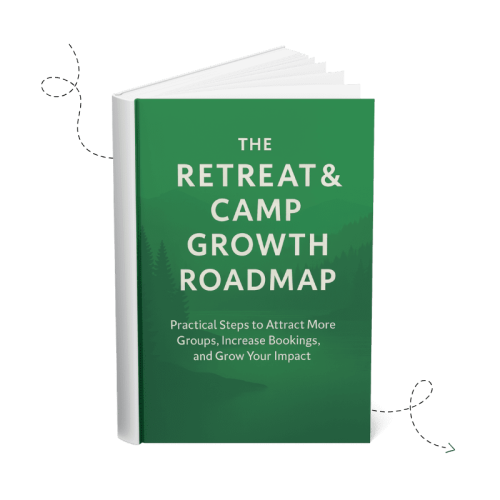Retreat & Camp Growth Roadmap Focus Area: Clarify Brand Messaging
Introduction
If you’re looking for practical retreat marketing tips, one of the most effective places to start is with clarified brand messaging. After you’ve defined who your retreat or camp is best suited to serve (see “Identify Your Audience”), the next focus area is learning how to speak to them clearly and consistently. That’s where brand messaging comes in.
“Craft Brand Messaging” is a focus area within the “Define Your Strategy” step of the Retreat & Camp Growth Roadmap—a practical system designed to help Christian retreat centers and camps increase bookings and deepen their ministry impact. This article will walk you through the messaging elements that every retreat or camp should define and how each one can help you attract and convert the right groups.
You’ll also get real-life inspired examples, access to a downloadable worksheet, and a link to view a completed sample guide.
Why This Focus Area Matters
Your message is more than marketing. It’s how you reveal the heart of your ministry to the world. Without clear, consistent messaging, even the best retreat center can get overlooked or misunderstood. Strong messaging is one of the most overlooked retreat marketing tips. It can transform how guests see and respond to your center.
When your website, emails, brochures, and ads all tell the same compelling story—in a tone that reflects your mission—you build trust faster and convert more inquiries into bookings. Too often, retreat centers blend in with vague descriptions, borrowed church language, or hospitality jargon that doesn’t connect with planners.
Clarified messaging doesn’t just make you sound better—it makes your center easier to find, understand, and say “yes” to.
Is This a Focus Area You Need to Work On?
Not sure if now is the right time to invest energy into crafting your brand messaging? Here are a few reflection questions to help you assess:
- Is your messaging inconsistent across your website, brochures, and emails?
- Do staff and volunteers clearly understand how to talk about your retreat or camp to potential guests?
- When new people hear or read about your ministry, do they immediately grasp who it’s for and what makes it unique?
- Are you confident in how your marketing copy reflects your mission and speaks to your audience?
- Is your messaging current and aligned with your most recent program or audience updates?
If you answered “no” to any of these, this focus area can help you bring greater clarity, alignment, and impact to your outreach and market your retreat center or camp effectively..
When your website, emails, brochures, and ads all tell the same compelling story—in a tone that reflects your mission—you build trust faster and convert more inquiries into bookings. Too often, retreat centers blend in with vague descriptions, borrowed church language, or hospitality jargon that doesn’t connect with planners.
Clarified messaging doesn’t just make you sound better—it makes your center easier to find, understand, and say “yes” to.
What This Focus Area Involves
Each of the following messaging components plays a unique role. Together, they form a cohesive message strategy that can guide all your communication efforts.
Brand Voice & Tone
What it is: Your brand voice and tone describe how your organization “sounds” across communication. Voice reflects your personality and values, while tone adjusts based on the context (e.g., website vs. personal email).
Why it matters: A consistent voice helps your audience feel like they know you. It builds familiarity, trust, and authenticity—especially important for faith-based ministries where alignment matters.
Where it’s used: Everywhere—website, brochures, emails, social media, signage, ads, and even how your staff speak to guests.
How to craft it:
- Identify 3–5 adjectives that describe your ministry personality (e.g., peaceful, practical, joyful, rooted).
- Define what your voice is—and what it is not.
- Include do/don’t examples for tone use in formal vs. casual settings.
Example: Shalom Springs Retreat Center serves pastors and missionaries in burnout recovery. Their voice is:
- Gentle but not overly sentimental
- Rooted in Scripture but not preachy
- Personal but not casual
This tone comes through in phrases like: “A quiet place to listen again” or “Space for your soul to rest.”

Unique Point of View
What it is: Your unique point of view is the core belief or philosophy that shapes how you serve. It answers the question: “What do we believe about retreats, transformation, and ministry that shapes how we operate?”
Why it matters: This defines your “why” and helps guests connect with your deeper purpose. It also guides your programming and decision-making.
Where it’s used: Mission statements, About pages, speaker introductions, promotional materials, and decision-making language.
How to craft it:
- Reflect on your founding story and mission.
- Identify one or two theological or ministry convictions that influence everything you do.
- Articulate how these shape the experience you create.
Example: Northbend Christian Camp serves youth group leaders planning summer and weekend retreats for teens. Their point of view is: “Life-changing faith moments happen when teens step away from distraction and experience God in community.” This belief shapes everything from their tech-free policy to evening worship under the stars, small group debriefs, and campfire testimonies—helping leaders create space where teens hear God’s voice and grow together.
Brandscript
What it is: A Brandscript is a framework for telling your ministry story using the structure of a compelling narrative. It’s based on the StoryBrand approach popularized by Donald Miller in his book Building a StoryBrand.
Why it matters: This format positions your audience as the hero and your ministry as the guide—flipping the traditional “about us” model to focus on what really matters to the guest.
Where it’s used: Website headlines, About page, sales copy, video scripts, and speaking engagements.
How to craft it:
- Identify the guest’s desire (what they want).
- Name the problem getting in the way.
- Present your retreat or camp as the guide.
- Provide a plan for how you help.
- Call them to action.
- Show what success looks like.
- Warn what’s at stake if they don’t act.
Example: Ironwood Men’s Retreat Center helps Christian men reconnect with their faith, families, and calling.
- Character: Christian men feeling spiritually dry, disconnected, or burned out
- Problem:
- External: Overloaded schedules, constant demands, and shallow community
- Internal: A sense of aimlessness, isolation, and spiritual fatigue
Philosophical: Men were never meant to walk through life without strong faith and brotherhood
- Guide:
- Empathy: We’ve been there—we understand the weight men carry in leadership, family, and faith
- Authority: For 20+ years, Ironwood has guided men toward spiritual renewal through immersive, Christ-centered retreats
- Plan:
- Choose your retreat weekend
- Experience a guided rhythm of rest, teaching, and brotherhood
- Return reconnected to your purpose and people
- Call to Action:
- Direct: Book Your Retreat
- Transitional: Download the Men’s Ministry Retreat Planning Guide
- Success: Men return spiritually recharged, equipped with vision, and strengthened in their relationships
- Failure: They continue drifting through life disconnected, overwhelmed, and unfulfilled
This structure ensures that all communication connects emotionally and calls guests forward.
Taglines
What it is: Taglines are short, memorable phrases that summarize your identity, mission, or unique benefit. They help make your ministry stick in someone’s mind.
Why it matters: A good tagline communicates clarity and builds trust. It can reinforce your mission, differentiate you, or appeal to your audience’s aspiration.
Where it’s used: Homepage headers, brochures, business cards, event banners, and email signatures.
How to craft it:
We recommend creating three taglines from different angles:
- One focused on experience or credibility
- One focused on results or value
- One focused on emotional aspiration
Example: Rest Haven Ministries provides personal retreats for Christian leaders.
- Experience/Credibility: “Trusted by pastors and missionaries since 1987.”
- Results/Value: “Get the rest you need to return with clarity and strength.”
- Emotional Aspiration: “Where weary leaders come to breathe again.”
Choose the one that fits your outreach need—or use different ones in different contexts.
Offer Statement
What it is: A short paragraph that clearly explains what you offer, who it’s for, and what outcome it helps achieve. Think of it as your “elevator pitch” in written form.
Why it matters: It helps people quickly understand if you’re a good fit for their group or need.
Where it’s used: On your homepage, in brochures, social media bios, proposals, and introductions.
How to craft it:
- Begin with who you serve.
- Clearly state what you provide.
- Name the result or transformation it leads to.
Common mistake: Being too generic (e.g., “a great place for spiritual retreats”) or cramming in too many details.
Example: Willow Springs Camp provides guided wilderness retreats for high school youth groups. We help teens grow deeper in faith and community through immersive, Christ-centered adventure experiences in the mountains of Montana.
Key Differentiators
What it is: The features or qualities that make your retreat or camp different from others.
Why it matters: Helps guests understand why they should choose you over another center.
Where it’s used: Comparison charts, brochures, FAQs, website, and during sales calls.
How to craft it:
- List your top 3–5 differentiators.
- Focus on meaningful differences (not just “we care”).
Example: Gracewood Christian Camp serves family retreats:
- Intergenerational programming
- Spiritual formation leaders on site
- Full worship space with AV support
- Flexible mealtimes for mixed ages
Company Description
What it is: A brief overview of your retreat or camp that summarizes who you are, what you offer, and who you serve.
Why it matters: It provides a quick and consistent introduction for people who are new to your ministry.
Where it’s used: Website About page, brochures, press kits, proposals, staff directories.
How to craft it:
- State your name and nonprofit/faith affiliation (if relevant).
- Describe what you offer and who it’s for.
- End with what makes the experience meaningful.
Example: Silver Pines Retreat Center is a faith-based nonprofit located in Northern California that hosts spiritual retreats for small churches and ministry teams. Known for its peaceful setting and personalized service, Silver Pines provides a welcoming space for reflection, reconnection, and spiritual renewal.
Company Story
What it is: Your founding story and ministry journey told in narrative form.
Why it matters: Stories connect. They provide meaning, mission, and emotion that facts alone can’t convey.
Where it’s used: Website, fundraising decks, brochures, videos, and partnership proposals.
How to craft it:
- Start with the “spark”—what need or calling led to your founding.
- Share what gap you set out to fill.
- Highlight milestones in your growth or evolution.
- Reinforce your ongoing mission.
Example: Hope Valley Camp began in 1989 when a group of local churches partnered to create a safe, gospel-centered summer program for under-resourced youth. Over the years, it expanded to year-round discipleship retreats while staying true to its mission of creating a place where kids encounter Christ through nature, community, and service.
Sample Marketing Messages
What it is: Reusable snippets of marketing copy written in four styles to appeal to different motivations.
Why it matters: Your audience isn’t all the same. Some care about transformation, others about logistics, others about emotional impact. These messages allow you to resonate with more of your audience in more places.
Where it’s used: Website copy, ad headlines, brochures, emails, and social posts.
The Four Types:
- Positive Objective – How you help them achieve something good.
- Positive Emotional – How your retreat makes them feel better.
- Emotional Relief – How you help them avoid something negative.
- Problem Solving – How you help them overcome a challenge.
Example: Cedar Path Retreat Center serves Christian college ministries planning student retreats.
- Positive Objective: Help your students build lasting faith and friendships in a focused, Christ-centered retreat experience.
- Positive Emotional: Watch your students light up as they worship under the stars and reconnect without distractions.
- Emotional Relief: Stop scrambling for venues that “almost work.” We make retreat planning easy so you can focus on your ministry.
- Problem Solving: Our all-inclusive packages and ministry-minded team take care of logistics, meals, and space—so you can lead with peace of mind.
Putting It All Together
Once you’ve crafted each of these messaging components, the next step is to compile them into a single, easy-to-use Brand Messaging Guide. This document becomes your go-to reference for all future marketing and sales communication. Share it with anyone who writes copy, manages your website, speaks to groups, answers inquiries, or creates promotional materials.
Benefits of having a central messaging guide:
- Keeps your voice and tone consistent across channels
- Speeds up content creation by giving clear copy blocks and talking points
- Helps new staff and volunteers quickly understand your ministry’s identity
- Builds alignment between your mission and your marketing
If you’d like to see a full example, click here to check out a completed brand messaging guide for a retreat center focusing on Men’s Ministry Retreats.

Practical Takeaways
Crafting your brand messaging isn’t just a marketing exercise—it’s a ministry alignment tool. When your communication reflects your heart, purpose, and strengths clearly, the right groups are more likely to find and choose you. This clarity is one of the simplest retreat marketing tips you can apply to improve the guest experience while strengthening outreach.
Here’s how to move forward:
- Download the Brand Messaging Worksheet to walk through each component with your team.
- Use our Brand Messaging Guide GPT built on ChatGPT for a AI -assisted helped based on this approach
- Start with voice, story, and differentiators, then move into writing your offer, key messages, and sample copy.
- Use real examples from past guests and feedback to guide the language you choose.
- Review everything through the lens of your audience. Does this speak to their hopes, fears, and goals?
- Apply your messaging across platforms—don’t just leave it in a document. Train your team to use it everywhere.
You don’t have to get this perfect. You just need to get it clear, authentic, and aligned with the guests you’re called to serve.
Ready to Take the Next Step?
Clarifying your message is one of the most transformational things you can do for your ministry outreach. With the right words in place, every email, page, and ad becomes more powerful.
If you found this helpful, here are four great next steps to continue your journey:
🧭 Move to the Next Focus Area: Improve Lead Handling
Learn to define how new inquiries are handled to ensure consistent, timely follow up.
[Read Improve Lead Handling]
📘 Download the Retreat & Camp Growth Roadmap eBook
Get the full 3-stage system we use to help Christian retreat centers and camps grow with clarity and purpose.
[Download the eBook]
🌱 Learn More About How We Help Retreat Centers & Camps
We’re a Christian-owned marketing agency that helps ministries grow attendance, bookings, and impact through practical strategies rooted in clarity and stewardship.
[See How We Can Help]
🤝 Schedule a Free Discovery Call
Want help applying this to your unique situation? Let’s talk. We’ll explore where you are now, where you want to go, and how to take the next faithful step.
[Book a Discovery Call]
You don’t have to figure this out alone. Let’s build something meaningful—together.
Frequently Asked Questions
What if we serve multiple types of groups—do we need separate messaging for each?
It depends. If the groups are very different (e.g., youth retreats vs. elder care weekends), it may help to create variations of certain messaging components for each audience. But often, a single unified message that emphasizes your core identity and flexibility is sufficient.
How often should we update our brand messaging?
Review your messaging at least once a year or when you make significant program changes. Messaging should evolve as your ministry grows but stay rooted in your mission.
Do we need a professional writer to complete our messaging guide?
Not necessarily. Many teams can draft strong messaging with guided exercises like the worksheet provided. However, an experienced partner can help refine and apply it more effectively.
How do we get buy-in from our staff or board?
Involve key team members early in the process. Use examples to show how consistent messaging supports both ministry and marketing goals. Position it as a tool for better communication and alignment.
Can this help with grant writing or fundraising?
Absolutely. Clear messaging makes your mission, impact, and needs easier to communicate, which strengthens applications and donor appeals.
What’s the difference between brand messaging and our mission statement?
Your mission statement is part of your messaging, but messaging is broader. It includes how you talk about your work to different audiences in different settings.
How do we use this messaging in our day-to-day marketing?
Integrate it into your website copy, email templates, social media, brochures, and team training. Think of it as a toolbox that keeps all your communication aligned.





